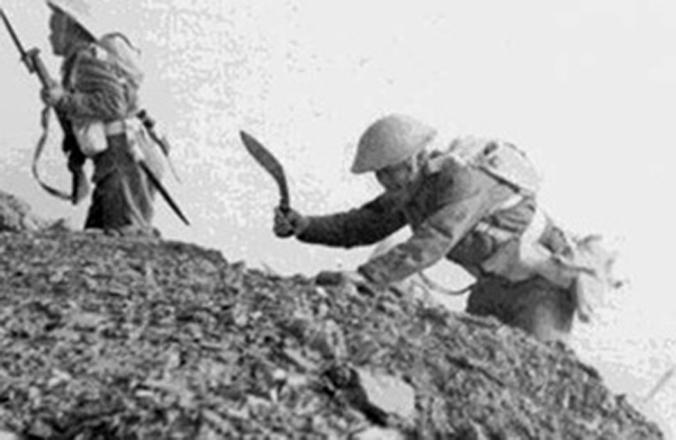Original WW1 Gurkha's Kukri Field Marshall Manekshaw once said, " If someone says he does not fear death, then he is either telling a lie or he is a Gurkha".
Part of a collection of 3 original military Gurkha's kukri, two WW2 and one WW1 and a WW2 Japanese soldiers flag {now sold}. All without scabbards, with very good blade with signs if combat use and surface marking and some areas of old pitting. They were all formerly on display on the walls of a defunct in 1968 regimental officer's mess the Royal Warwickshire Regt, moved when it merged in 1968 to become Fusilier Brigade with a WW2 Japanese silk flag. All 4 pieces are being sold by us separately. Tempered steel blade and carved wood hilt. The Kukri is the renown and famous weapon of the Nepalese Gurkha.A Superb WW1 Gurkha's Kukri Combat Knife "Ayo Gorkali" The Gurkha Battle Call "The Gurkhas Are Coming!" Field Marshall Manekshaw once said, " If someone says he does not fear death, then he is either telling a lie or he is a Gurkha". The Gukhas are the finest and bravest, combat soldiers in the world, with legendary loyalty to the British Crown. When worn in combat it would normally be in a khaki canvas cover. Superb tempered steel blade, overall in fabulous condition. Field Marshall Sam Manekshaw once said, " If someone says he does not fear death, then he is either telling a lie or he is a Gurkha". On 12/13 May 1945 at Taungdaw, Burma now Myanmar, Rifleman Lachhiman Gurung VC was manning the most forward post of his platoon which bore the brunt of an attack by at least 200 of the Japanese enemy. Twice he hurled back grenades which had fallen on his trench, but the third exploded in his right hand, blowing off his fingers, shattering his arm and severely wounding him in the face, body and right leg. His two comrades were also badly wounded but the rifleman, now alone and disregarding his wounds, loaded and fired his rifle with his left hand for four hours, calmly waiting for each attack which he met with fire at point blank range. Afterwards, when the casualties were counted, it is reported that there were 31 dead Japanese around his position which he had killed, with only one arm.In the Falklands War in 1982 the Argentinians abandoned Mount William without a fight simply because the enemy forces advancing towards them were the 2nd Battalion, 7th Ghurka Rifles. Probably the most respected and feared warriors in the world, the Gurkhas of Nepal have fought in the Gurkha regiments of the British Army for around two centuries. With a degree of loyalty and dedication that is legendary, there is no greater soldier to be at one's side when in battle than the noble Gurkha. With a Kukri in his hand and the battle cry called, "Ayo Gorkhali!" "the Gurkhas are coming!", no foe's head was safe on his shoulders. Battle hardened German Infantry in WW1, or WW2 Japanese Shock Troops, have been known to tremble in their boots at the knowledge that they would be facing the Gurkhas in battle. Some of the most amazing feats of heroism have resulted in the most revered medal, the British Victoria Cross the world's greatest and most difficult to qualify for gallantry medal being awarded to Ghurkas. The blade shape descended from the classic Greek sword of Kopis, which is about 2500 years old.
Some say it originated from a form of knife first used by the Mallas who came to power in Nepal in the 13th Century. There are some Khukuris displaying on the walls of National Museum at Chhauni in Kathmandu which are 500 years old or even older, among them, one that once belonged to Drabya Shah, the founder king of the kingdom of Gorkha, in 1627 AD. But, some say that the Khukuri's history is possibly centuries older this. It is suggested that the Khukuri was first used by Kiratis who came to power in Nepal before Lichchhavi age, in about the 7th Century. In the hands of an experienced wielder Khukuri or Kukri is about as formidable a weapon as can be conceived. Like all really good weapons, Khukuri's or Kukri's efficiency depends much more upon skill than the strength of the wielder. And thus so that it happens, that a diminutive Gurkha, a mere boy in regards to his stature, could easily cut to pieces a gigantic adversary, who simply does not understand the little Gurkha's mode of attack and fearsome skill. The Gurkha generally strikes upwards with his Kukri, possibly in order to avoid wounding himself should his blow fail, and possibly because an upward cut is just the one that can be least guarded against however strong his opponent. Approx 18.5 inches long
Code: 23722
295.00 GBP








